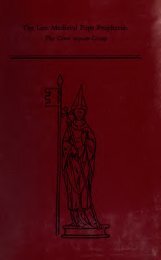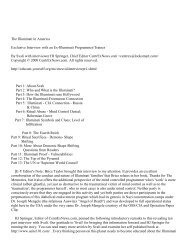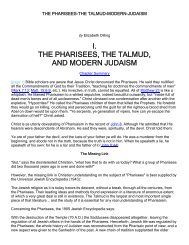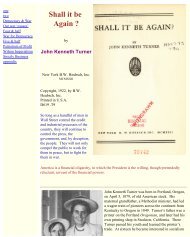You also want an ePaper? Increase the reach of your titles
YUMPU automatically turns print PDFs into web optimized ePapers that Google loves.
<strong>Fascist</strong> <strong>Spectacle</strong> http://content.cdlib.org/xtf/view?docId=ft18700444&chunk.id=0&doc.v...<br />
negotiate the polyvalent meanings he was attributing to power, war, and empire. This image<br />
constituted a constant motif in the regime's discourse. As such, it prepared the ideological and<br />
symbolic terrain on which fascism founded its justification for war as the time approached for Italy to<br />
initiate its Ethiopian conquest.<br />
The fascist regime's interest in Ethiopia followed a history of Italian expansionist attempts<br />
beginning at the end of the nineteenth century, during the governments of Agostino De Pretis and<br />
Francesco Crispi. Both prime ministers focused their search for new territories in the African area<br />
around the Red Sea; during their regency Italy initiated its penetration of Eritrea, Somalia, and<br />
Abyssinia, although amid some unfavorable circumstances. A most significant failure occurred in 1893,<br />
during Crispi's second government, when Italy advanced its politics of expansionism in Abyssinia. The<br />
emperor Menelik reacted to the Italians' military threat by organizing a strong army, and in 1896 he<br />
managed to inflict a large defeat on the Italians at Adowa, where Italy lost six thousand soldiers. The<br />
defeat remained vivid in popular memory and became a symbolic moment in Italy's colonial struggle, a<br />
humiliation to be revenged. With the beginning of the new century, Italy's colonial politics was still<br />
oriented toward the northern African coast. Diplomatic agreements established between 1902 and<br />
1904 with France, England, and Tunisia acknowledged Italy's interests in Tripolitania (Libya) and<br />
Cyrenaica. In 1911, backed by this political support, Giolitti, then prime minister, decided it was time<br />
for Italy to actualize its colonial goals. Although Italy had no economic interest in those regions,<br />
questions of prestige and the geopolitics of the time [91] encouraged Giolitti's government to declare<br />
war on Turkey, on whom Libya depended. Within a month, because of the political and economic crisis<br />
of the Ottoman Empire, the Italian army was able to occupy a strategic point in the Tripolitania region,<br />
but in the long run the<br />
― 168 ―<br />
persistence of sporadic warfare created several obstacles to the successful completion of the invasion.<br />
Within this context, and because Giolitti's government intended to avoid a compromise peace pact,<br />
two months after the first attack, and well before the war was concluded, Italy printed a royal decree<br />
establishing its absolute sovereignty over Libya. A year later the Lausanne peace treaty conferred<br />
upon Italy the right of sovereignty over Libya, and public opinion acclaimed the country's first colonial<br />
success.<br />
With respect to its colonial politics in Ethiopia, Italy's military preparation during the 1900s and<br />
1910s was conceived primarily in terms of a defensive strategy against an eventual Abyssinian<br />
invasion of the Italian possession of Eritrea. [92] In the 1920s Mussolini's fascist government continued<br />
the policy of the liberal government and even signed a treaty of friendship with Ethiopia in 1928. [93]<br />
By the end of the decade, however, the fascist regime called for a politics of force that would pursue<br />
the disintegration of the Ethiopian empire. [94] Thus, in 1932, with Mussolini's consent, Minister of<br />
Colonies Emilio De Bono officially began the preparation for an aggressive campaign in Abyssinia.<br />
At its inception, the campaign's exact goals were not clear, nor was the beginning date decided.<br />
The operation actually underwent several changes over the following year, partly because of the<br />
presence of two different centers of power, the military and the politicians, whose opinions on war<br />
objectives and strategies differed widely. [95] In February 1934 Mussolini convened the first meeting<br />
on the operation and communicated his decision to begin the invasion of Ethiopia in 1935. [96] Military<br />
leaders expressed concern about this early date because, according to them, it did not leave adequate<br />
time to prepare for what they envisioned as a war of conquest. The course of events, however,<br />
contributed to determine this early start to the colonial war. The relations between Italy and Ethiopia<br />
having deteriorated drastically at the end of 1934, rumors spread about an Abyssinian mobilization.<br />
The rumor proved to be unfounded, but the situation motivated Mussolini—who was convinced for a<br />
series of reasons that "time works against us"—to prepare a final plan of aggression in Ethiopia. The<br />
invasion, as he wrote in his memorandum to the highest authorities of the regime, was supposed to<br />
take place in 1935; and, Mussolini added, it needed to aim at the "total conquest of Ethiopia."<br />
The problem of the Italo-Abyssinian relations recently moved to a different level: from diplomatic problem it has become<br />
a problem of force . It is a historical problem that we need to solve with the only means with which such problems have<br />
always been solved: with the employment of arms. . . .<br />
― 169 ―<br />
Committed to this war, the objective cannot but be the destruction of the Abyssinian armed forces and the total conquest<br />
of Ethiopia. The empire cannot be done otherwise. [97]<br />
99 of 199 7/11/2006 12:54 AM









